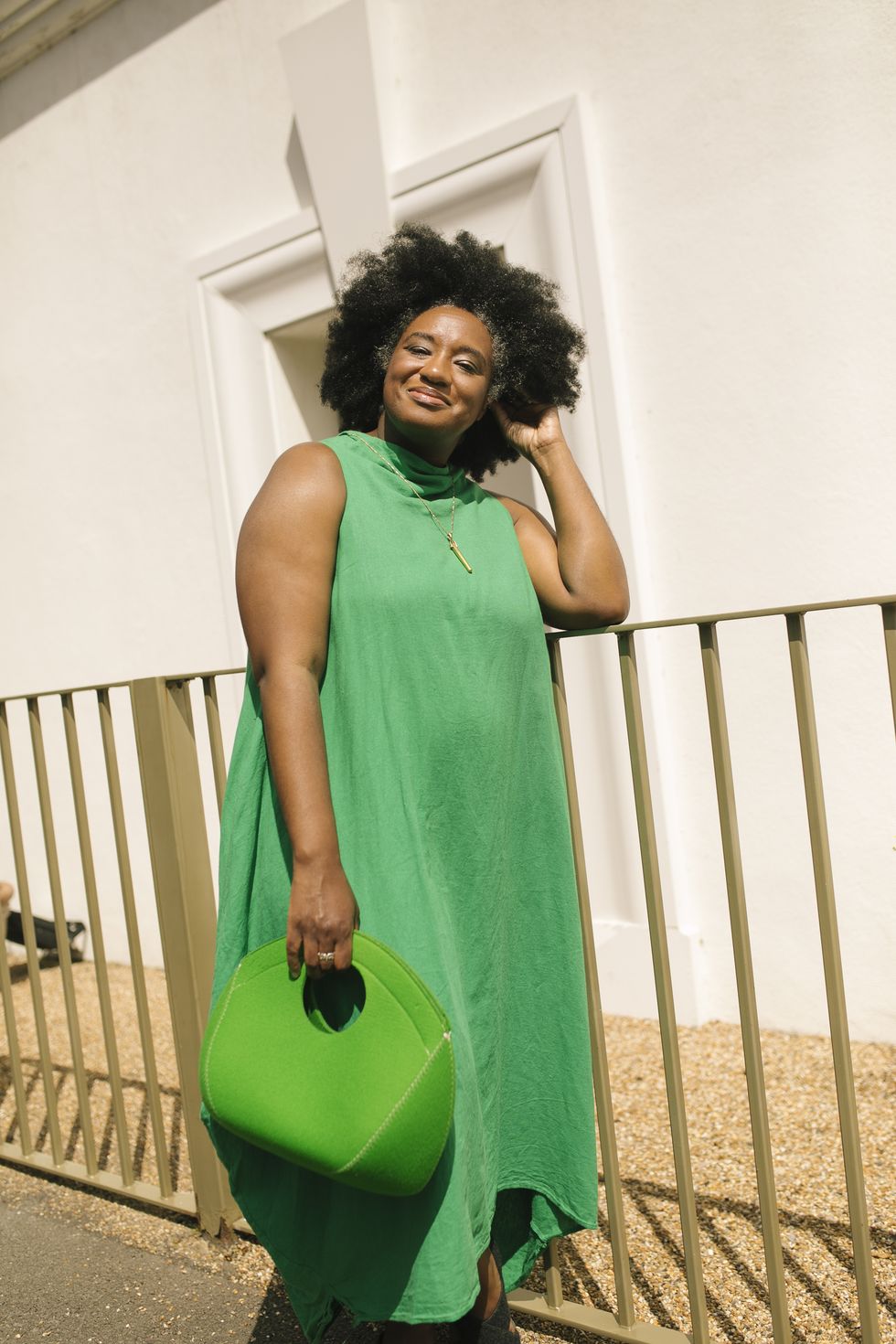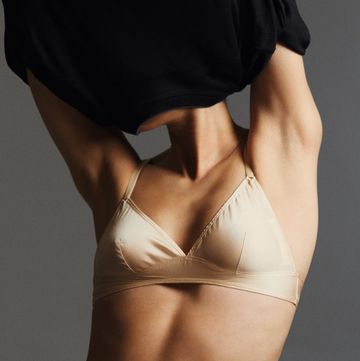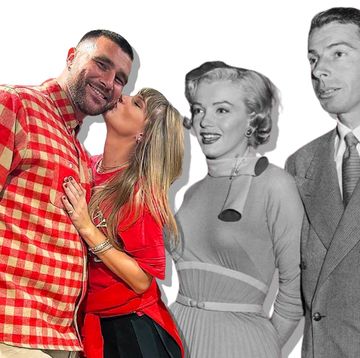I find myself packing up a colourful Christopher John Rogers striped sweater to be delivered to my colleague Ronaé Fagon’s house. It’s not that I don’t want the sweater; in fact, I totally love it. It’s that we agreed to share it. We both spotted it at the ELLE UK Absolut Swap last year... and both went for it. (I got there first, let the record show. Also, you should come to ELLE swaps, they’re always the best.)
The truth is, I have a lot of knitwear. A shelf’s worth, to be honest, collected over the course of a decade. In fact, I’d go so far as to say that when people think of me, they think of colourful knitwear. And if you already have so much of something, why not... share. So when Ronaé and I, clearly with mutual impeccable taste, both reached for the same garment on the rack, rather than fight it out, I realised there was an elegant solution to our conundrum. I suggested that I enjoy the sweater that winter (2023) and the following year I would send it her way so she could enjoy it too. Because a striped sweater is pretty timeless and never goes out of style. In this way, not only is the item going to get more use than most of the clothing in our wardrobe, but it means we both get to enjoy something fabulous. Moreover, the garment now has a wonderful story that we’ll share with friends, hopefully sparking others in our circles to consider doing the same. In this scenario, everyone wins.
FIND OUT MORE ON ELLE COLLECTIVE
Of course, this isn’t the first time I’ve shared my clothing. Growing up in Virginia as the middle of three girls in the Nineties meant ‘ownership’ was a meaningless concept. The absolute bangers of items in our wardrobes got worn by everybody. Not that this always ended happily. When we were teenagers, I vividly remember a favourite T-shirt I had bought and loved getting left out in the sun by one sister (a careless mistake), causing its beautiful bright-red colour to fade to orange (Aisha, you still owe me). Obviously, I’m not quite over that one – a lesson in the perils of siblings. But, more often than not, sharing was the dream. In particular, I think about all my rude streetwear that I brought home from the UK after my first stint in London, that was worn by each of my sisters in turn and today resides in my pre-teen niece’s wardrobe because it fits her perfectly – which does leave me wondering how on earth it ever fit us. There have been a great many purchases that have made their way through four sets of hands within one family.
So, naturally, I now take the same approach with my friends. It was something I had to circle back to. It started in about 2008, when my best friend Sofia and I came up with the notion of a ‘long-term loan’. Anything I wasn’t currently wearing in my wardrobe that was still great, I would gift to her as a ‘L-TL’. What that has come to mean is simply that the item may well stay with the recipient forever, but the giver always retains the option to claim it back if they miss it. I have found this to be a great way to circulate pieces that I feel guilty about not giving the love they clearly deserve. Ultimately, what I want most is a wardrobe of well-worked clothing, not pristine unworn clothing. In my opinion, if someone is wearing an item, it’s a win. That’s what it was created for, after all. Not for collecting! And increasingly, happily, I know I am far from being the only one who is feeling this way.
Sometimes we remain attached to our clothing even when it no longer fits. The Jil Sander Raf Simons-era winter coat that I got at a steep discount and wore to the White House with my Grammy (who is gone) has certainly not grown with my middle-aged body. It’s still such a beautiful piece, with huge sentimental value to me, but I have so many wonderful coats. I knew it was time to move it on, and selling it just didn’t feel right. But Lora... it would definitely fit Lora Nikolaeva (my best friend and the designer behind the label Lora Gene). So I brought it to lunch one day, and presented it to her as a Christmas gift.
‘Are you sure?’ she asked, knowing the value of this item to me. I couldn’t have been more sure. First and foremost, Lora loves and appreciates clothing. There’s no way this coat won’t be taken care of and treated with love. The first thing she did was to exclaim ‘But this is Raf!’ I rest my case. The next thing she did was to show it to her friend Nicky Pachev in Bulgaria, who’s also a designer with a Raf Simons appreciation. We want our clothes to have a life with someone who will love them – and this was love. But just like with Sofia and my long-term loan, if ever I decided I did want the coat back or if my body changed again, I know that Lora would happily hand it back to me. This system really works for a reason – it means we all get to enjoy more clothes, and the pieces we enjoy have a life beyond us.
Fair-fashion campaigner Venetia La Manna, like me, grew up in a household of girls and sharing. Today, La Manna still shares with her friends in ways I find quite sweet. One such friend sent La Manna, ‘a box with a few of her dresses (and books!) to borrow for a while, “Just because”’. When I’ve gone on holiday, she has made me up a tote bag of a few summery pieces and maybe some swimwear, too. There’s never any pressure to wear anything, but if we do there’s a mutual understanding that we will take the best possible care of it and return it in good time.
As a matter of fact, in my circle of fashion lovers, the principle of the sharing economy is the core belief. I’ll never forget my very first Milan Fashion Week in September 2023. I attended the Prada and Gucci shows, but unfortunately I didn’t own any of their bags. Luckily my dear friend Julie Sandlander brought a bag for me to use so I wouldn’t feel out of place. She is a wonder! Camille Charrière (fellow ELLE UK contributing editor) has also offered to loan me bags in times of need. I’m always touched by the generosity of someone lending me such a precious possession and trusting me to take care of it.
I wanted to see whether the concept of the shared wardrobe was extending beyond those of us who work in the fashion industry, so I polled my 241K followers on Instagram (a highly scientific method) to see how many of my readership were happy to loan things regularly, or even buy things together with friends and family to be shared. A whopping 55% are currently sharing things in their wardrobes with loved ones. This poll encouraged my friend Kellie Dalton, head of regeneration at House of Hackney, to reach out to chat more. Dalton has worked as a sustainability consultant for luxury brands for years and has a wardrobe of dreams. She’s also one of the most generous people I’ve ever met. ‘Anything I think someone likes more than I do (even if I like it), I’ll just give it to them. Better to think someone is really getting something out of a piece that’s not getting enough use in my wardrobe,’ Dalton says.
I’m the same. Note to my readers: make friends with sustainable fashion people and comment a lot when they have something you love. You’ll be first in line for the taking during a closet clean-out. I’m seeing this attitude replicated all over, so I had to reach out to some experts for their opinion as well. I started with my mate Kalkidan Legesse, CEO of the wardrobe digitisation and resale app OWNI. As another person with siblings, Legesse can definitely speak to a feeling of shared ownership of clothing while growing up. She smiles when she thinks of her upbringing in this way.
‘Growing up, I shared clothes with everyone in my house (whether they liked it or not). My dad’s socks (men’s socks are much better quality), my brother’s T-shirts, my sister’s dresses (four years older than me so perfect for festivals/going out), Mum’s coats, etc. My mum would joke that she was grateful we weren’t the same shoe size, otherwise she wouldn’t have any shoes left.’ I ask Legesse whether these attitudes we carry from our experiences are being reflected in the wider world. She tells me that people surveyed by OWNI’s app, ‘regularly wear less than 30% of their closets, but hold on to things for ages’. While still relatively new, Owni already has over 3,500 users. You’ll be wise to get in early on this one – sharing and reselling is the future.
It makes business sense. Just ask Eshita Kabra. She was so inspired by her experiences of sharing that she started a social network for renting clothes. Kabra believes it was wanting to share clothes with her friends growing up, and everyone being different sizes, that inspired her drive to create By Rotation. She wanted something that made it possible for her to, ‘lend virtually my entire wardrobe, rent from others’ wardrobes and monitor my fashion consumption’. She was on to something – By Rotation now has over 420,000 users in the UK and US, and over 115,000 items in its shared wardrobe.
When I consider the popularity of both resale and clothes- sharing apps, I sometimes find myself feeling quite hopeful about the future of fashion. While the industry may contribute significantly to the climate emergency, the solutions don’t always have to be taxing and terrible. As a matter of fact, in my opinion sharing is downright fun. Combine peer-to-peer loaning and resale with major corporations embracing a slower growth model (hint, hint, nudge, nudge corporations) and we could possibly get to a place where we can have all the things we love about fashion while, crucially, losing many of the things we don’t.
The truth is, in these trying times of climate crisis caused by corporate and human greed, now is as good a time as any to start thinking about all the ways we need to share better. When I was growing up, sharing clothes with siblings was frankly not something to shout about. And neither was buying your clothing second-hand. If someone had told me I would have a career writing about these things I would have rolled my eyes and told them not to tell anyone that my jeans were pre-loved. But now, more often than not I’m happy to see ‘the way we did things’ celebrated. Because, quite honestly, learning to share is the only way forward out of this mess we’re in.
ELLE Collective is a new community of fashion, beauty and culture lovers. For access to exclusive content, events, inspiring advice from our Editors and industry experts, as well the opportunity to meet designers, thought-leaders and stylists, become a member today HERE.















